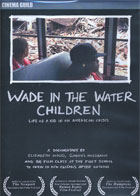
Wade in the Water, Children: Life as a Kid in an American Crisis 2008
Distributed by Cinema Guild, 115 West 30th Street, Suite 800, New York, NY 10001; 212-685-6242
Produced by Elizabeth Wood and Gabriel Nussbaum
Directed by Elizabeth Wood and Gabriel Nussbaum
DVD, color, 75 min.
Jr. High - Adult
African American Studies, Education
Date Entered: 11/18/2009
Reviewed by Patricia B. McGee, Coordinator of Media Services, Volpe Library & Media Center, Tennessee Technological UniversityIn 2006, one year after Hurricane Katrina, independent film makers, Elizabeth Wood and Gabriel Nussbaum traveled to New Orleans to teach free film making classes to school children. They provided students from the documentary film class at Singleton Charter Middle School, the first school to open in the city after the storm, with cameras to film their stories—their lives, their families, their neighborhoods. Wade in the Water, Children is the result of this collaboration. The film is an eye opening and disturbing examination of what happened from “the children’s point of view,” a story that is funny, bitter, profane and extraordinarily perceptive.
The kids lived in Central City, an inner city neighbor. Some like Bernard had homes in the projects, others like Brenton and Jessica had already experienced violent death, “It’s part of growing up in the hood.” Wade in the Water, Children is an intimate look into the lives of children who have survived unspeakable horrors and who can insist one moment that “it never was better,” yet in the next express a hope to go to Princeton. As might be expected from such youthful and inexperienced cinematographers, their cameras range all over the place. Derion’s story included footage of a street arrest, her brother cleaning his handguns, a dead spider on the wall, followed by a panorama shot of where “the sun will rise at.”
As an entirety the film is a searing and heartbreaking portrait of the failures of New Orleans to help its most disadvantaged citizens both pre and post Katrina. Many of these kids were troubled; the storm simply made existing problems worse. Their communities, however fragile and tenuous they may have been, were destroyed by the storm, yet nothing has replaced them. Two years later the camera captures a child running on a sidewalk brandishing a handgun, rubble from destroyed buildings is piled high, houses are boarded up. Troubled children continue to struggle with difficult family situations, violent neighborhoods, overcrowded and under resourced schools, depression and post traumatic stress. Ms. Cook, the principal of Singleton School, summed up the situation concisely, there is “nothing here for the troubled youth. ...Nothing in place in this city for the troubled child.”